Market Opportunity Report: Analyzing Ingogo's India Entry
VerifiedAdded on 2022/12/09
|15
|4423
|317
Report
AI Summary
This Market Opportunity Report assesses the potential for Ingogo, an Australian taxi app, to enter the Indian market. The report begins with an executive summary and provides background information on Ingogo, highlighting its key differentiators such as fixed fares and a focus on professional drivers, in contrast to competitors like Uber and Ola. The report then introduces the Indian market, discussing consumer preferences and the dominance of Uber and Ola while noting customer dissatisfaction with surge pricing. A PESTEL analysis is conducted, examining the political, economic, social, technological, environmental, and legal factors influencing the ride-hailing industry in India. This analysis identifies opportunities related to changing consumer behavior and Ingogo's unique selling points. A SWOT analysis further evaluates Ingogo's strengths, weaknesses, opportunities, and threats in the Indian market. The report concludes with critical success factors for Ingogo in India, emphasizing the importance of a competitive business model and the ability to satisfy both commuters and drivers.
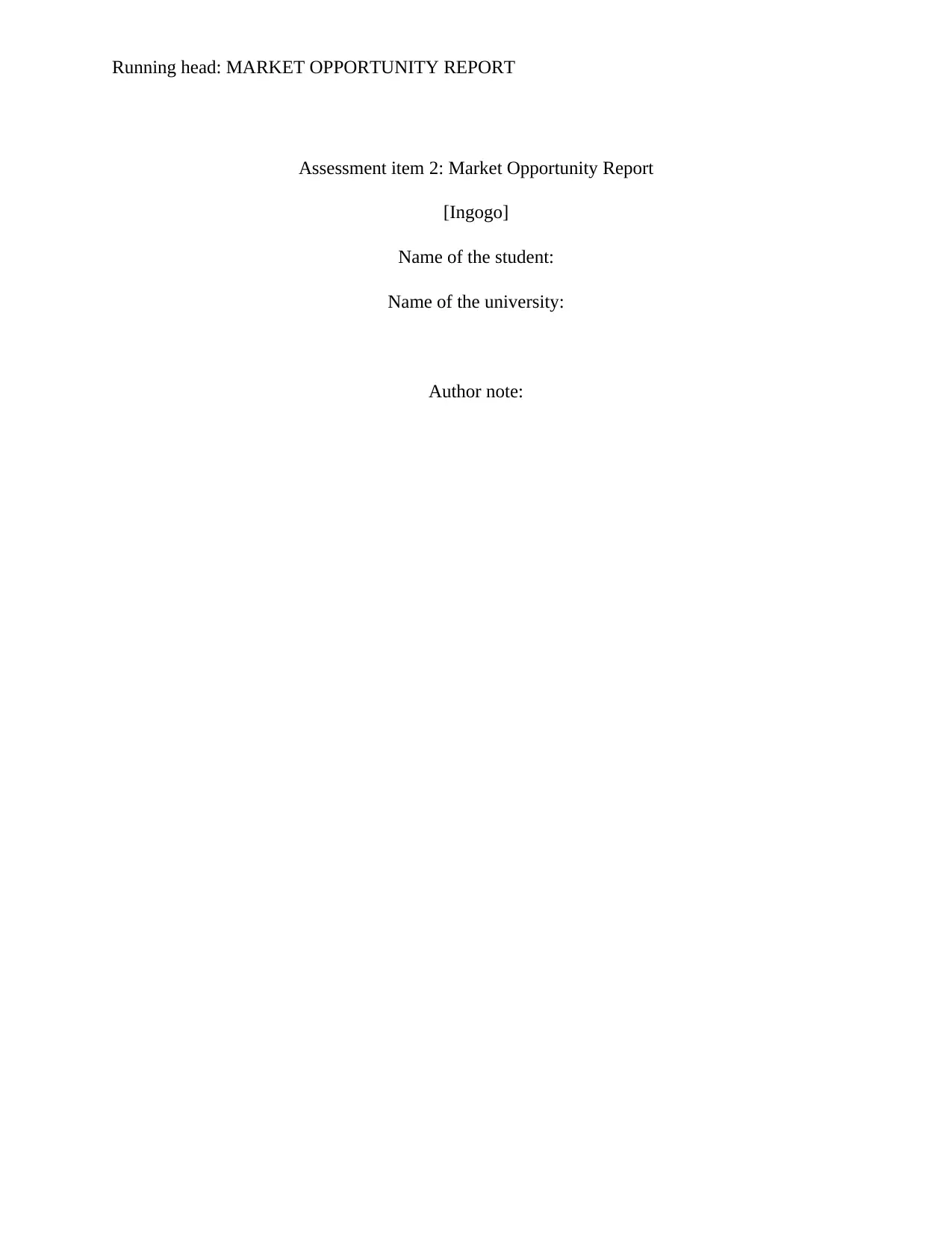
Running head: MARKET OPPORTUNITY REPORT
Assessment item 2: Market Opportunity Report
[Ingogo]
Name of the student:
Name of the university:
Author note:
Assessment item 2: Market Opportunity Report
[Ingogo]
Name of the student:
Name of the university:
Author note:
Paraphrase This Document
Need a fresh take? Get an instant paraphrase of this document with our AI Paraphraser
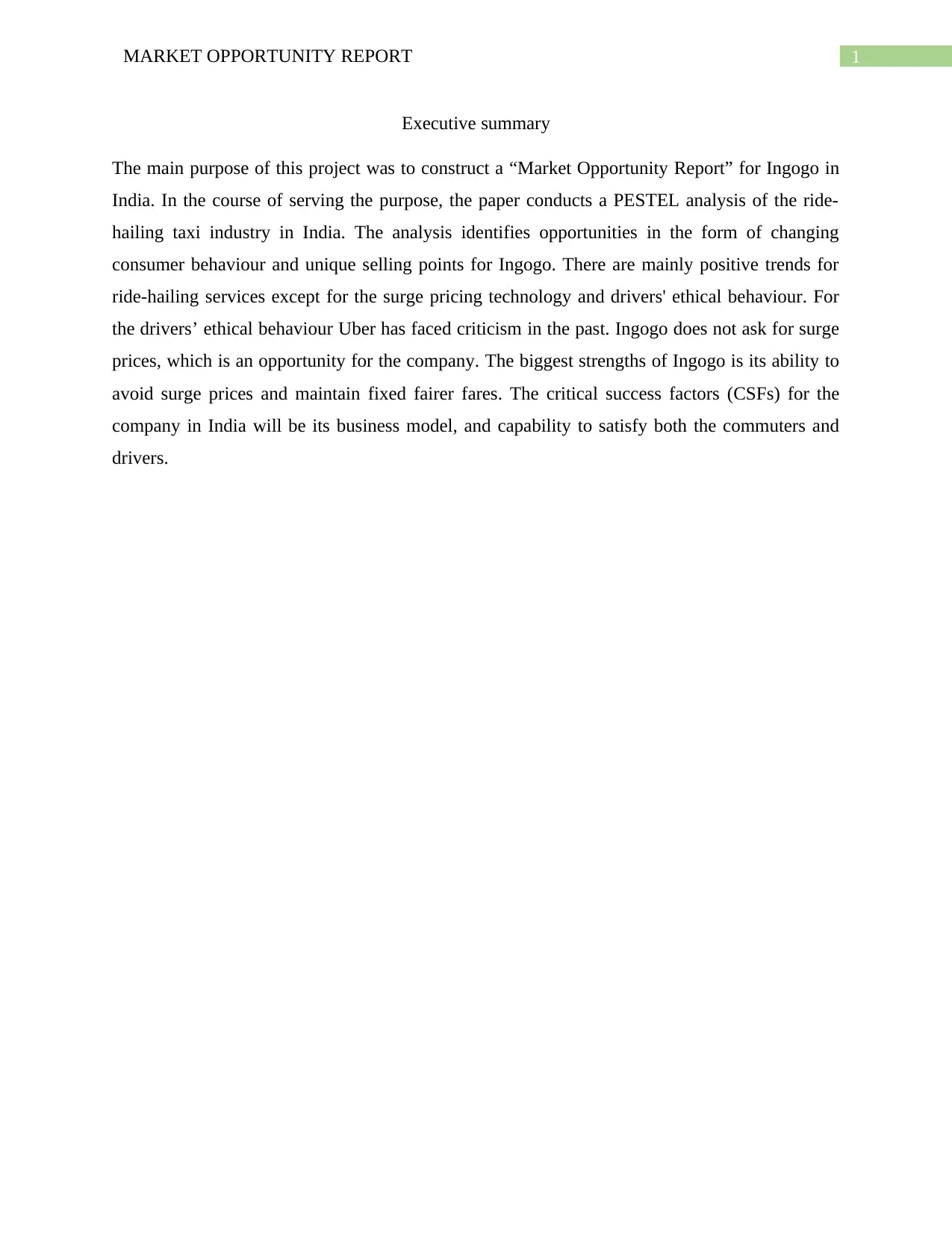
1MARKET OPPORTUNITY REPORT
Executive summary
The main purpose of this project was to construct a “Market Opportunity Report” for Ingogo in
India. In the course of serving the purpose, the paper conducts a PESTEL analysis of the ride-
hailing taxi industry in India. The analysis identifies opportunities in the form of changing
consumer behaviour and unique selling points for Ingogo. There are mainly positive trends for
ride-hailing services except for the surge pricing technology and drivers' ethical behaviour. For
the drivers’ ethical behaviour Uber has faced criticism in the past. Ingogo does not ask for surge
prices, which is an opportunity for the company. The biggest strengths of Ingogo is its ability to
avoid surge prices and maintain fixed fairer fares. The critical success factors (CSFs) for the
company in India will be its business model, and capability to satisfy both the commuters and
drivers.
Executive summary
The main purpose of this project was to construct a “Market Opportunity Report” for Ingogo in
India. In the course of serving the purpose, the paper conducts a PESTEL analysis of the ride-
hailing taxi industry in India. The analysis identifies opportunities in the form of changing
consumer behaviour and unique selling points for Ingogo. There are mainly positive trends for
ride-hailing services except for the surge pricing technology and drivers' ethical behaviour. For
the drivers’ ethical behaviour Uber has faced criticism in the past. Ingogo does not ask for surge
prices, which is an opportunity for the company. The biggest strengths of Ingogo is its ability to
avoid surge prices and maintain fixed fairer fares. The critical success factors (CSFs) for the
company in India will be its business model, and capability to satisfy both the commuters and
drivers.
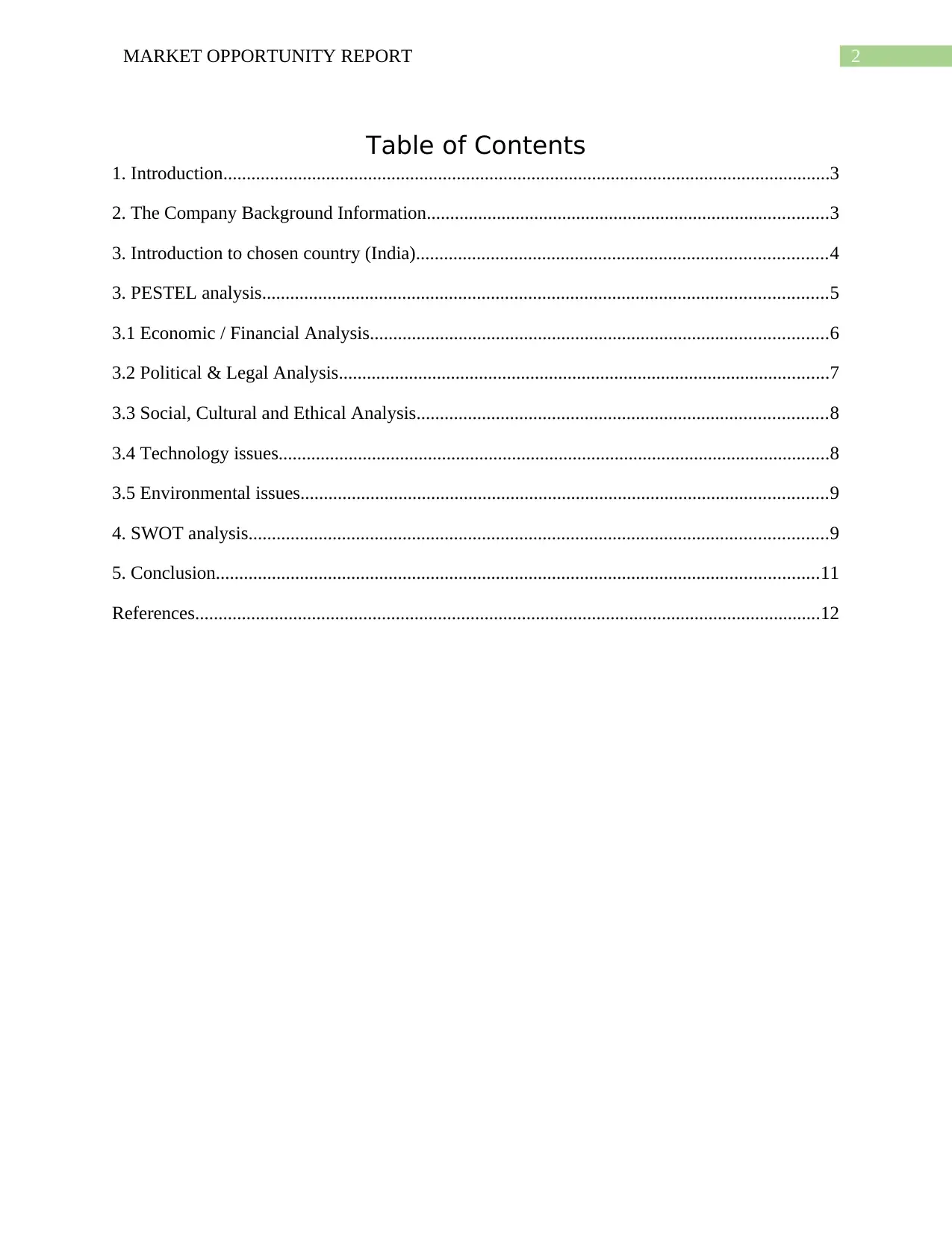
2MARKET OPPORTUNITY REPORT
Table of Contents
1. Introduction..................................................................................................................................3
2. The Company Background Information......................................................................................3
3. Introduction to chosen country (India)........................................................................................4
3. PESTEL analysis.........................................................................................................................5
3.1 Economic / Financial Analysis..................................................................................................6
3.2 Political & Legal Analysis.........................................................................................................7
3.3 Social, Cultural and Ethical Analysis........................................................................................8
3.4 Technology issues......................................................................................................................8
3.5 Environmental issues.................................................................................................................9
4. SWOT analysis............................................................................................................................9
5. Conclusion.................................................................................................................................11
References......................................................................................................................................12
Table of Contents
1. Introduction..................................................................................................................................3
2. The Company Background Information......................................................................................3
3. Introduction to chosen country (India)........................................................................................4
3. PESTEL analysis.........................................................................................................................5
3.1 Economic / Financial Analysis..................................................................................................6
3.2 Political & Legal Analysis.........................................................................................................7
3.3 Social, Cultural and Ethical Analysis........................................................................................8
3.4 Technology issues......................................................................................................................8
3.5 Environmental issues.................................................................................................................9
4. SWOT analysis............................................................................................................................9
5. Conclusion.................................................................................................................................11
References......................................................................................................................................12
⊘ This is a preview!⊘
Do you want full access?
Subscribe today to unlock all pages.

Trusted by 1+ million students worldwide
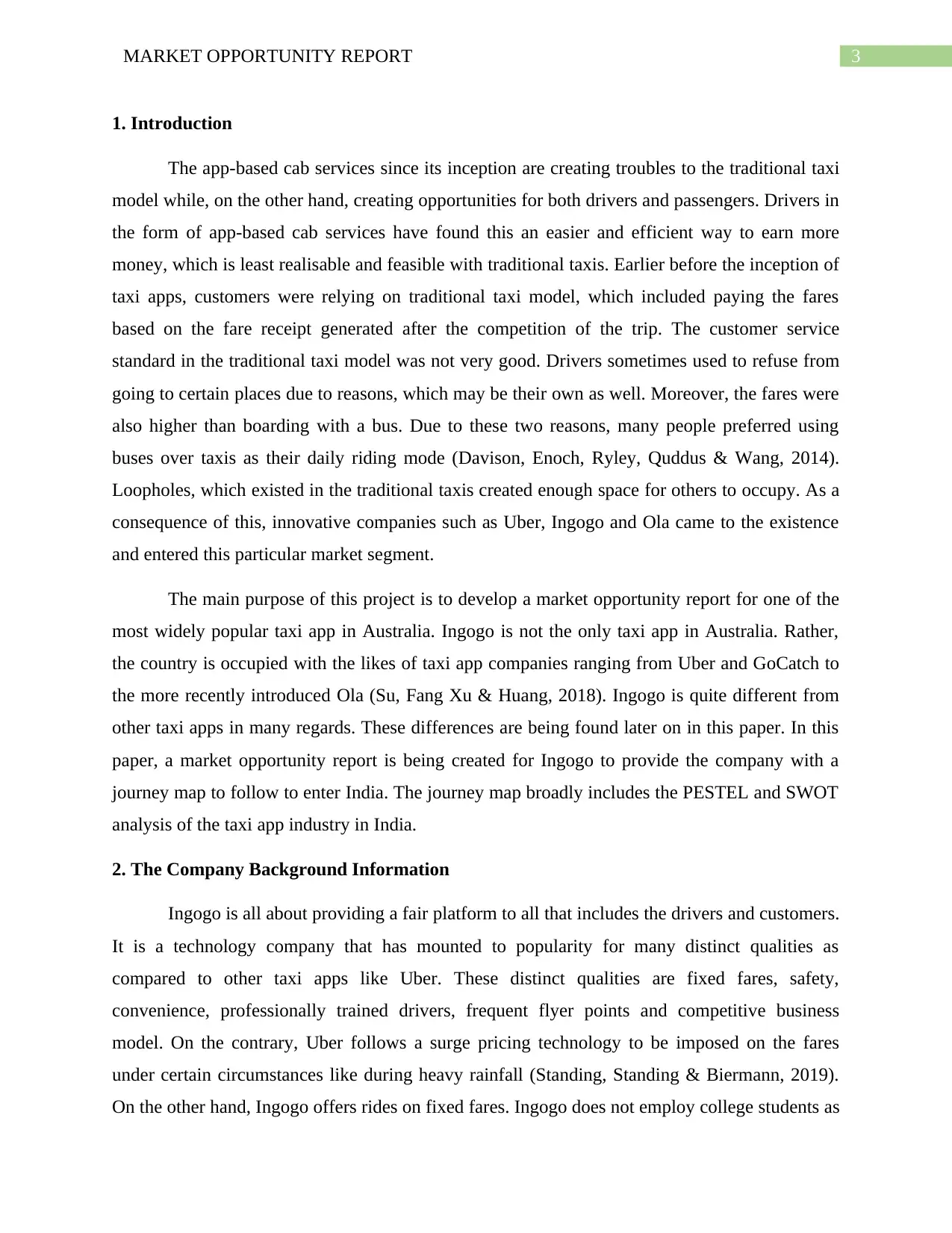
3MARKET OPPORTUNITY REPORT
1. Introduction
The app-based cab services since its inception are creating troubles to the traditional taxi
model while, on the other hand, creating opportunities for both drivers and passengers. Drivers in
the form of app-based cab services have found this an easier and efficient way to earn more
money, which is least realisable and feasible with traditional taxis. Earlier before the inception of
taxi apps, customers were relying on traditional taxi model, which included paying the fares
based on the fare receipt generated after the competition of the trip. The customer service
standard in the traditional taxi model was not very good. Drivers sometimes used to refuse from
going to certain places due to reasons, which may be their own as well. Moreover, the fares were
also higher than boarding with a bus. Due to these two reasons, many people preferred using
buses over taxis as their daily riding mode (Davison, Enoch, Ryley, Quddus & Wang, 2014).
Loopholes, which existed in the traditional taxis created enough space for others to occupy. As a
consequence of this, innovative companies such as Uber, Ingogo and Ola came to the existence
and entered this particular market segment.
The main purpose of this project is to develop a market opportunity report for one of the
most widely popular taxi app in Australia. Ingogo is not the only taxi app in Australia. Rather,
the country is occupied with the likes of taxi app companies ranging from Uber and GoCatch to
the more recently introduced Ola (Su, Fang Xu & Huang, 2018). Ingogo is quite different from
other taxi apps in many regards. These differences are being found later on in this paper. In this
paper, a market opportunity report is being created for Ingogo to provide the company with a
journey map to follow to enter India. The journey map broadly includes the PESTEL and SWOT
analysis of the taxi app industry in India.
2. The Company Background Information
Ingogo is all about providing a fair platform to all that includes the drivers and customers.
It is a technology company that has mounted to popularity for many distinct qualities as
compared to other taxi apps like Uber. These distinct qualities are fixed fares, safety,
convenience, professionally trained drivers, frequent flyer points and competitive business
model. On the contrary, Uber follows a surge pricing technology to be imposed on the fares
under certain circumstances like during heavy rainfall (Standing, Standing & Biermann, 2019).
On the other hand, Ingogo offers rides on fixed fares. Ingogo does not employ college students as
1. Introduction
The app-based cab services since its inception are creating troubles to the traditional taxi
model while, on the other hand, creating opportunities for both drivers and passengers. Drivers in
the form of app-based cab services have found this an easier and efficient way to earn more
money, which is least realisable and feasible with traditional taxis. Earlier before the inception of
taxi apps, customers were relying on traditional taxi model, which included paying the fares
based on the fare receipt generated after the competition of the trip. The customer service
standard in the traditional taxi model was not very good. Drivers sometimes used to refuse from
going to certain places due to reasons, which may be their own as well. Moreover, the fares were
also higher than boarding with a bus. Due to these two reasons, many people preferred using
buses over taxis as their daily riding mode (Davison, Enoch, Ryley, Quddus & Wang, 2014).
Loopholes, which existed in the traditional taxis created enough space for others to occupy. As a
consequence of this, innovative companies such as Uber, Ingogo and Ola came to the existence
and entered this particular market segment.
The main purpose of this project is to develop a market opportunity report for one of the
most widely popular taxi app in Australia. Ingogo is not the only taxi app in Australia. Rather,
the country is occupied with the likes of taxi app companies ranging from Uber and GoCatch to
the more recently introduced Ola (Su, Fang Xu & Huang, 2018). Ingogo is quite different from
other taxi apps in many regards. These differences are being found later on in this paper. In this
paper, a market opportunity report is being created for Ingogo to provide the company with a
journey map to follow to enter India. The journey map broadly includes the PESTEL and SWOT
analysis of the taxi app industry in India.
2. The Company Background Information
Ingogo is all about providing a fair platform to all that includes the drivers and customers.
It is a technology company that has mounted to popularity for many distinct qualities as
compared to other taxi apps like Uber. These distinct qualities are fixed fares, safety,
convenience, professionally trained drivers, frequent flyer points and competitive business
model. On the contrary, Uber follows a surge pricing technology to be imposed on the fares
under certain circumstances like during heavy rainfall (Standing, Standing & Biermann, 2019).
On the other hand, Ingogo offers rides on fixed fares. Ingogo does not employ college students as
Paraphrase This Document
Need a fresh take? Get an instant paraphrase of this document with our AI Paraphraser
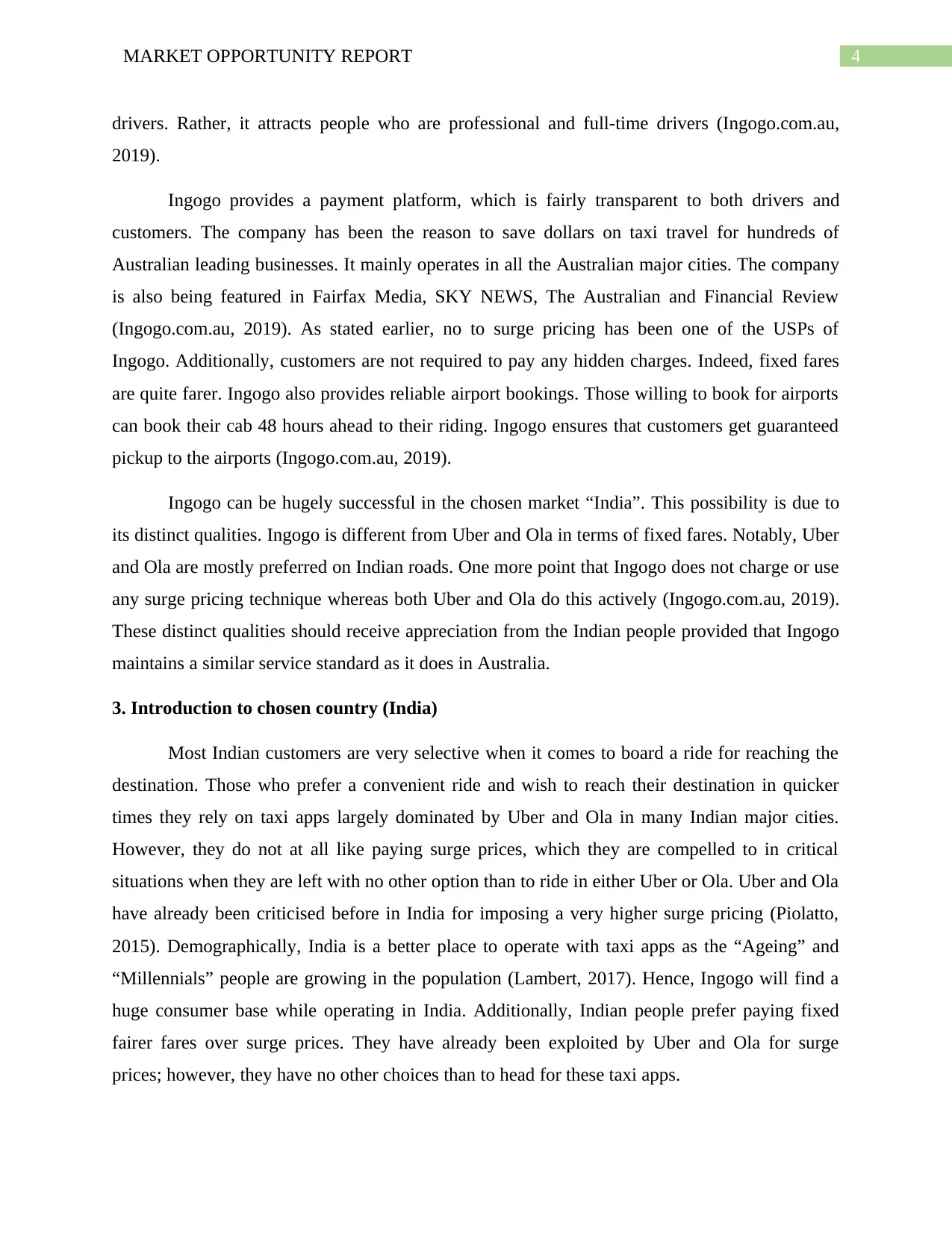
4MARKET OPPORTUNITY REPORT
drivers. Rather, it attracts people who are professional and full-time drivers (Ingogo.com.au,
2019).
Ingogo provides a payment platform, which is fairly transparent to both drivers and
customers. The company has been the reason to save dollars on taxi travel for hundreds of
Australian leading businesses. It mainly operates in all the Australian major cities. The company
is also being featured in Fairfax Media, SKY NEWS, The Australian and Financial Review
(Ingogo.com.au, 2019). As stated earlier, no to surge pricing has been one of the USPs of
Ingogo. Additionally, customers are not required to pay any hidden charges. Indeed, fixed fares
are quite farer. Ingogo also provides reliable airport bookings. Those willing to book for airports
can book their cab 48 hours ahead to their riding. Ingogo ensures that customers get guaranteed
pickup to the airports (Ingogo.com.au, 2019).
Ingogo can be hugely successful in the chosen market “India”. This possibility is due to
its distinct qualities. Ingogo is different from Uber and Ola in terms of fixed fares. Notably, Uber
and Ola are mostly preferred on Indian roads. One more point that Ingogo does not charge or use
any surge pricing technique whereas both Uber and Ola do this actively (Ingogo.com.au, 2019).
These distinct qualities should receive appreciation from the Indian people provided that Ingogo
maintains a similar service standard as it does in Australia.
3. Introduction to chosen country (India)
Most Indian customers are very selective when it comes to board a ride for reaching the
destination. Those who prefer a convenient ride and wish to reach their destination in quicker
times they rely on taxi apps largely dominated by Uber and Ola in many Indian major cities.
However, they do not at all like paying surge prices, which they are compelled to in critical
situations when they are left with no other option than to ride in either Uber or Ola. Uber and Ola
have already been criticised before in India for imposing a very higher surge pricing (Piolatto,
2015). Demographically, India is a better place to operate with taxi apps as the “Ageing” and
“Millennials” people are growing in the population (Lambert, 2017). Hence, Ingogo will find a
huge consumer base while operating in India. Additionally, Indian people prefer paying fixed
fairer fares over surge prices. They have already been exploited by Uber and Ola for surge
prices; however, they have no other choices than to head for these taxi apps.
drivers. Rather, it attracts people who are professional and full-time drivers (Ingogo.com.au,
2019).
Ingogo provides a payment platform, which is fairly transparent to both drivers and
customers. The company has been the reason to save dollars on taxi travel for hundreds of
Australian leading businesses. It mainly operates in all the Australian major cities. The company
is also being featured in Fairfax Media, SKY NEWS, The Australian and Financial Review
(Ingogo.com.au, 2019). As stated earlier, no to surge pricing has been one of the USPs of
Ingogo. Additionally, customers are not required to pay any hidden charges. Indeed, fixed fares
are quite farer. Ingogo also provides reliable airport bookings. Those willing to book for airports
can book their cab 48 hours ahead to their riding. Ingogo ensures that customers get guaranteed
pickup to the airports (Ingogo.com.au, 2019).
Ingogo can be hugely successful in the chosen market “India”. This possibility is due to
its distinct qualities. Ingogo is different from Uber and Ola in terms of fixed fares. Notably, Uber
and Ola are mostly preferred on Indian roads. One more point that Ingogo does not charge or use
any surge pricing technique whereas both Uber and Ola do this actively (Ingogo.com.au, 2019).
These distinct qualities should receive appreciation from the Indian people provided that Ingogo
maintains a similar service standard as it does in Australia.
3. Introduction to chosen country (India)
Most Indian customers are very selective when it comes to board a ride for reaching the
destination. Those who prefer a convenient ride and wish to reach their destination in quicker
times they rely on taxi apps largely dominated by Uber and Ola in many Indian major cities.
However, they do not at all like paying surge prices, which they are compelled to in critical
situations when they are left with no other option than to ride in either Uber or Ola. Uber and Ola
have already been criticised before in India for imposing a very higher surge pricing (Piolatto,
2015). Demographically, India is a better place to operate with taxi apps as the “Ageing” and
“Millennials” people are growing in the population (Lambert, 2017). Hence, Ingogo will find a
huge consumer base while operating in India. Additionally, Indian people prefer paying fixed
fairer fares over surge prices. They have already been exploited by Uber and Ola for surge
prices; however, they have no other choices than to head for these taxi apps.
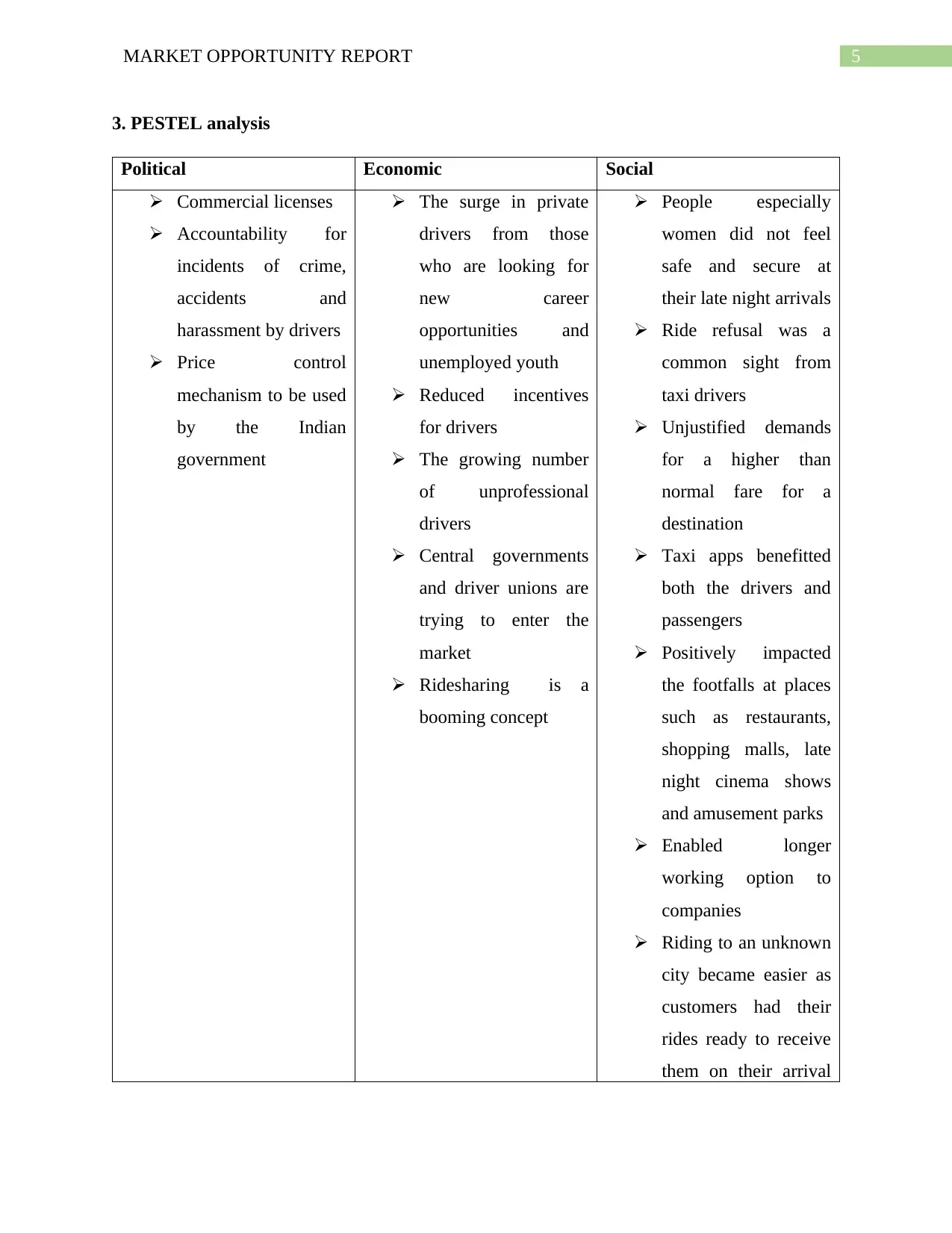
5MARKET OPPORTUNITY REPORT
3. PESTEL analysis
Political Economic Social
Commercial licenses
Accountability for
incidents of crime,
accidents and
harassment by drivers
Price control
mechanism to be used
by the Indian
government
The surge in private
drivers from those
who are looking for
new career
opportunities and
unemployed youth
Reduced incentives
for drivers
The growing number
of unprofessional
drivers
Central governments
and driver unions are
trying to enter the
market
Ridesharing is a
booming concept
People especially
women did not feel
safe and secure at
their late night arrivals
Ride refusal was a
common sight from
taxi drivers
Unjustified demands
for a higher than
normal fare for a
destination
Taxi apps benefitted
both the drivers and
passengers
Positively impacted
the footfalls at places
such as restaurants,
shopping malls, late
night cinema shows
and amusement parks
Enabled longer
working option to
companies
Riding to an unknown
city became easier as
customers had their
rides ready to receive
them on their arrival
3. PESTEL analysis
Political Economic Social
Commercial licenses
Accountability for
incidents of crime,
accidents and
harassment by drivers
Price control
mechanism to be used
by the Indian
government
The surge in private
drivers from those
who are looking for
new career
opportunities and
unemployed youth
Reduced incentives
for drivers
The growing number
of unprofessional
drivers
Central governments
and driver unions are
trying to enter the
market
Ridesharing is a
booming concept
People especially
women did not feel
safe and secure at
their late night arrivals
Ride refusal was a
common sight from
taxi drivers
Unjustified demands
for a higher than
normal fare for a
destination
Taxi apps benefitted
both the drivers and
passengers
Positively impacted
the footfalls at places
such as restaurants,
shopping malls, late
night cinema shows
and amusement parks
Enabled longer
working option to
companies
Riding to an unknown
city became easier as
customers had their
rides ready to receive
them on their arrival
⊘ This is a preview!⊘
Do you want full access?
Subscribe today to unlock all pages.

Trusted by 1+ million students worldwide

6MARKET OPPORTUNITY REPORT
to the city
Technological Legal Environmental
Compatibility of the
technology with
smartphones
Improvements in
journey estimation,
abuse reports, point to
point travel, support
system, transparency
in receipts and
statements
With real-time
tracking both
commuter and taxi
app can track the rides
Digital money transfer
system through
Paytm, credit card,
debit card and UPI
helped the commuter
to go cashless
The Supreme Court of
India is about to make
a plea concerning the
accountability of taxi
apps for drivers'
offenses
There are taxes like
Service tax and now
GST
In some states, the
government is trying
to bring the fares at
par with regular and
traditional taxis
It has boosted the
number of cars on
roads and hence,
contributing hugely
with its carbon
footprint impact
From a different
perspective, taxi apps
are becoming one of
the reasons for
reducing the number
of traditional taxis that
are mostly old
modeled and less
environmental
efficient
Table 1: PESTEL analysis
(Source: Basu, 2019)
3.1 Economic / Financial Analysis
The surge in private drivers is an opportunity for Ingogo. The unemployed youth and
many others have found joining taxi apps as a very profitable option for their career. However,
very healthy pay benefits for the drivers must be designed so as to be able to attract both the new
and existing drivers who are already working with Uber and Ola (Basu, 2019). Reduced
incentives due to the increased market competition are in contradiction with employee benefits
to the city
Technological Legal Environmental
Compatibility of the
technology with
smartphones
Improvements in
journey estimation,
abuse reports, point to
point travel, support
system, transparency
in receipts and
statements
With real-time
tracking both
commuter and taxi
app can track the rides
Digital money transfer
system through
Paytm, credit card,
debit card and UPI
helped the commuter
to go cashless
The Supreme Court of
India is about to make
a plea concerning the
accountability of taxi
apps for drivers'
offenses
There are taxes like
Service tax and now
GST
In some states, the
government is trying
to bring the fares at
par with regular and
traditional taxis
It has boosted the
number of cars on
roads and hence,
contributing hugely
with its carbon
footprint impact
From a different
perspective, taxi apps
are becoming one of
the reasons for
reducing the number
of traditional taxis that
are mostly old
modeled and less
environmental
efficient
Table 1: PESTEL analysis
(Source: Basu, 2019)
3.1 Economic / Financial Analysis
The surge in private drivers is an opportunity for Ingogo. The unemployed youth and
many others have found joining taxi apps as a very profitable option for their career. However,
very healthy pay benefits for the drivers must be designed so as to be able to attract both the new
and existing drivers who are already working with Uber and Ola (Basu, 2019). Reduced
incentives due to the increased market competition are in contradiction with employee benefits
Paraphrase This Document
Need a fresh take? Get an instant paraphrase of this document with our AI Paraphraser
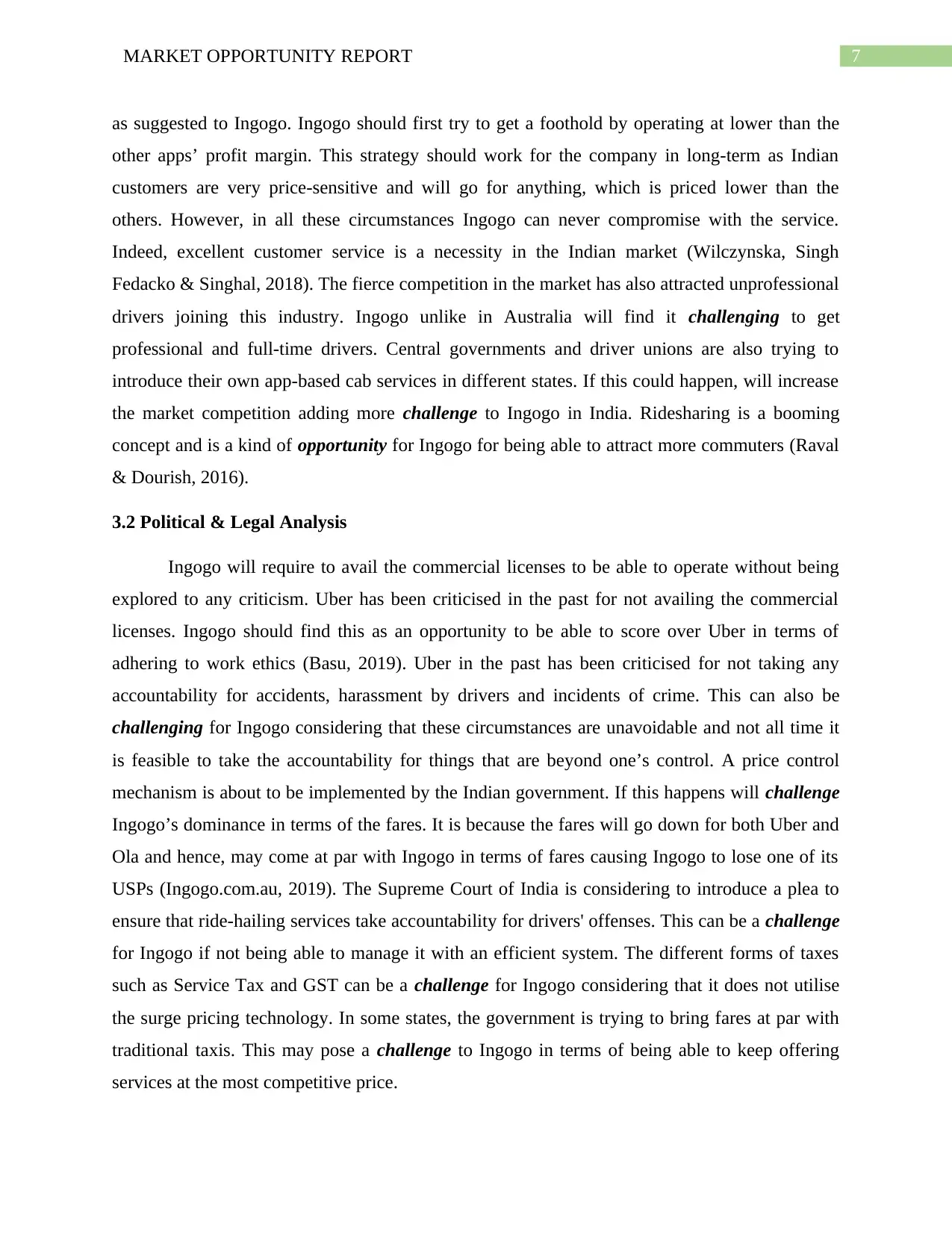
7MARKET OPPORTUNITY REPORT
as suggested to Ingogo. Ingogo should first try to get a foothold by operating at lower than the
other apps’ profit margin. This strategy should work for the company in long-term as Indian
customers are very price-sensitive and will go for anything, which is priced lower than the
others. However, in all these circumstances Ingogo can never compromise with the service.
Indeed, excellent customer service is a necessity in the Indian market (Wilczynska, Singh
Fedacko & Singhal, 2018). The fierce competition in the market has also attracted unprofessional
drivers joining this industry. Ingogo unlike in Australia will find it challenging to get
professional and full-time drivers. Central governments and driver unions are also trying to
introduce their own app-based cab services in different states. If this could happen, will increase
the market competition adding more challenge to Ingogo in India. Ridesharing is a booming
concept and is a kind of opportunity for Ingogo for being able to attract more commuters (Raval
& Dourish, 2016).
3.2 Political & Legal Analysis
Ingogo will require to avail the commercial licenses to be able to operate without being
explored to any criticism. Uber has been criticised in the past for not availing the commercial
licenses. Ingogo should find this as an opportunity to be able to score over Uber in terms of
adhering to work ethics (Basu, 2019). Uber in the past has been criticised for not taking any
accountability for accidents, harassment by drivers and incidents of crime. This can also be
challenging for Ingogo considering that these circumstances are unavoidable and not all time it
is feasible to take the accountability for things that are beyond one’s control. A price control
mechanism is about to be implemented by the Indian government. If this happens will challenge
Ingogo’s dominance in terms of the fares. It is because the fares will go down for both Uber and
Ola and hence, may come at par with Ingogo in terms of fares causing Ingogo to lose one of its
USPs (Ingogo.com.au, 2019). The Supreme Court of India is considering to introduce a plea to
ensure that ride-hailing services take accountability for drivers' offenses. This can be a challenge
for Ingogo if not being able to manage it with an efficient system. The different forms of taxes
such as Service Tax and GST can be a challenge for Ingogo considering that it does not utilise
the surge pricing technology. In some states, the government is trying to bring fares at par with
traditional taxis. This may pose a challenge to Ingogo in terms of being able to keep offering
services at the most competitive price.
as suggested to Ingogo. Ingogo should first try to get a foothold by operating at lower than the
other apps’ profit margin. This strategy should work for the company in long-term as Indian
customers are very price-sensitive and will go for anything, which is priced lower than the
others. However, in all these circumstances Ingogo can never compromise with the service.
Indeed, excellent customer service is a necessity in the Indian market (Wilczynska, Singh
Fedacko & Singhal, 2018). The fierce competition in the market has also attracted unprofessional
drivers joining this industry. Ingogo unlike in Australia will find it challenging to get
professional and full-time drivers. Central governments and driver unions are also trying to
introduce their own app-based cab services in different states. If this could happen, will increase
the market competition adding more challenge to Ingogo in India. Ridesharing is a booming
concept and is a kind of opportunity for Ingogo for being able to attract more commuters (Raval
& Dourish, 2016).
3.2 Political & Legal Analysis
Ingogo will require to avail the commercial licenses to be able to operate without being
explored to any criticism. Uber has been criticised in the past for not availing the commercial
licenses. Ingogo should find this as an opportunity to be able to score over Uber in terms of
adhering to work ethics (Basu, 2019). Uber in the past has been criticised for not taking any
accountability for accidents, harassment by drivers and incidents of crime. This can also be
challenging for Ingogo considering that these circumstances are unavoidable and not all time it
is feasible to take the accountability for things that are beyond one’s control. A price control
mechanism is about to be implemented by the Indian government. If this happens will challenge
Ingogo’s dominance in terms of the fares. It is because the fares will go down for both Uber and
Ola and hence, may come at par with Ingogo in terms of fares causing Ingogo to lose one of its
USPs (Ingogo.com.au, 2019). The Supreme Court of India is considering to introduce a plea to
ensure that ride-hailing services take accountability for drivers' offenses. This can be a challenge
for Ingogo if not being able to manage it with an efficient system. The different forms of taxes
such as Service Tax and GST can be a challenge for Ingogo considering that it does not utilise
the surge pricing technology. In some states, the government is trying to bring fares at par with
traditional taxis. This may pose a challenge to Ingogo in terms of being able to keep offering
services at the most competitive price.
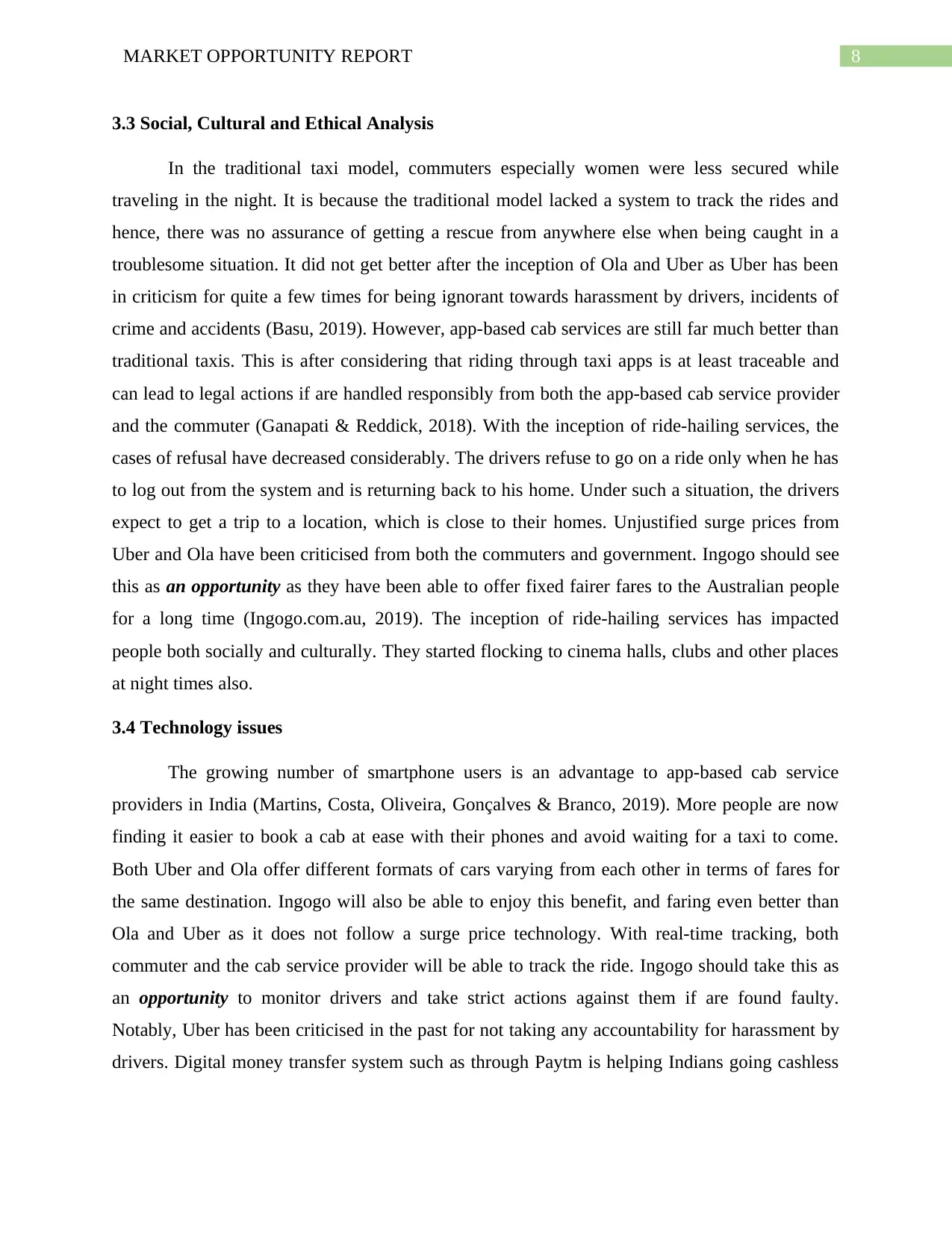
8MARKET OPPORTUNITY REPORT
3.3 Social, Cultural and Ethical Analysis
In the traditional taxi model, commuters especially women were less secured while
traveling in the night. It is because the traditional model lacked a system to track the rides and
hence, there was no assurance of getting a rescue from anywhere else when being caught in a
troublesome situation. It did not get better after the inception of Ola and Uber as Uber has been
in criticism for quite a few times for being ignorant towards harassment by drivers, incidents of
crime and accidents (Basu, 2019). However, app-based cab services are still far much better than
traditional taxis. This is after considering that riding through taxi apps is at least traceable and
can lead to legal actions if are handled responsibly from both the app-based cab service provider
and the commuter (Ganapati & Reddick, 2018). With the inception of ride-hailing services, the
cases of refusal have decreased considerably. The drivers refuse to go on a ride only when he has
to log out from the system and is returning back to his home. Under such a situation, the drivers
expect to get a trip to a location, which is close to their homes. Unjustified surge prices from
Uber and Ola have been criticised from both the commuters and government. Ingogo should see
this as an opportunity as they have been able to offer fixed fairer fares to the Australian people
for a long time (Ingogo.com.au, 2019). The inception of ride-hailing services has impacted
people both socially and culturally. They started flocking to cinema halls, clubs and other places
at night times also.
3.4 Technology issues
The growing number of smartphone users is an advantage to app-based cab service
providers in India (Martins, Costa, Oliveira, Gonçalves & Branco, 2019). More people are now
finding it easier to book a cab at ease with their phones and avoid waiting for a taxi to come.
Both Uber and Ola offer different formats of cars varying from each other in terms of fares for
the same destination. Ingogo will also be able to enjoy this benefit, and faring even better than
Ola and Uber as it does not follow a surge price technology. With real-time tracking, both
commuter and the cab service provider will be able to track the ride. Ingogo should take this as
an opportunity to monitor drivers and take strict actions against them if are found faulty.
Notably, Uber has been criticised in the past for not taking any accountability for harassment by
drivers. Digital money transfer system such as through Paytm is helping Indians going cashless
3.3 Social, Cultural and Ethical Analysis
In the traditional taxi model, commuters especially women were less secured while
traveling in the night. It is because the traditional model lacked a system to track the rides and
hence, there was no assurance of getting a rescue from anywhere else when being caught in a
troublesome situation. It did not get better after the inception of Ola and Uber as Uber has been
in criticism for quite a few times for being ignorant towards harassment by drivers, incidents of
crime and accidents (Basu, 2019). However, app-based cab services are still far much better than
traditional taxis. This is after considering that riding through taxi apps is at least traceable and
can lead to legal actions if are handled responsibly from both the app-based cab service provider
and the commuter (Ganapati & Reddick, 2018). With the inception of ride-hailing services, the
cases of refusal have decreased considerably. The drivers refuse to go on a ride only when he has
to log out from the system and is returning back to his home. Under such a situation, the drivers
expect to get a trip to a location, which is close to their homes. Unjustified surge prices from
Uber and Ola have been criticised from both the commuters and government. Ingogo should see
this as an opportunity as they have been able to offer fixed fairer fares to the Australian people
for a long time (Ingogo.com.au, 2019). The inception of ride-hailing services has impacted
people both socially and culturally. They started flocking to cinema halls, clubs and other places
at night times also.
3.4 Technology issues
The growing number of smartphone users is an advantage to app-based cab service
providers in India (Martins, Costa, Oliveira, Gonçalves & Branco, 2019). More people are now
finding it easier to book a cab at ease with their phones and avoid waiting for a taxi to come.
Both Uber and Ola offer different formats of cars varying from each other in terms of fares for
the same destination. Ingogo will also be able to enjoy this benefit, and faring even better than
Ola and Uber as it does not follow a surge price technology. With real-time tracking, both
commuter and the cab service provider will be able to track the ride. Ingogo should take this as
an opportunity to monitor drivers and take strict actions against them if are found faulty.
Notably, Uber has been criticised in the past for not taking any accountability for harassment by
drivers. Digital money transfer system such as through Paytm is helping Indians going cashless
⊘ This is a preview!⊘
Do you want full access?
Subscribe today to unlock all pages.

Trusted by 1+ million students worldwide

9MARKET OPPORTUNITY REPORT
(Humbani & Wiese, 2018). Ingogo will be benefitted from this by enabling customers to pay in a
variety of cashless modes.
3.5 Environmental issues
There are growing environmental challenges to ride-hailing services. There is a
continuous surge in vehicles on Indian roads due to the growing business of Uber and Ola. With
this, the amount of carbon emissions is also growing. The other way of avoiding this to be a
challenge for Ingogo is to invest in vehicles those that are technologically upgraded and possess
a higher environmental waste reduction efficiency (Shapiro, 2016). However, by going this way
Ingogo will not be able to attract huge participation from Indian drivers as all of them may not be
able to afford to buy expensive vehicles. Notably, the loan repayment structure for expensive
vehicles is less bearable to many drivers.
4. SWOT analysis
Strengths Weaknesses
Well-recognised brand
High-quality service
Dual rating systems such as from both
customers' and drivers' end boost trust
and safety
Work flexibility
Fixed fairer fares
No use of surge technology
Ingogo has no worries attracting the
investors
The threat of entrants is high as
switchover cost is quite manageable
Loyalty between Ingogo and its
drivers are relatively healthier as
compared to Uber; however, it does
not offer full-time permanent
employment
Unlike with Uber, there is a good
bonding between Ingogo and its
customers
Loan repayment is challenging
Data privacy is an issue
Opportunities Threats
Ride-hailing services can be availed
by even booking 48 hours prior to the
journey. No more waiting
Any kind of conflict with local
authorities can attract penalties, will
also earn a poor PR
(Humbani & Wiese, 2018). Ingogo will be benefitted from this by enabling customers to pay in a
variety of cashless modes.
3.5 Environmental issues
There are growing environmental challenges to ride-hailing services. There is a
continuous surge in vehicles on Indian roads due to the growing business of Uber and Ola. With
this, the amount of carbon emissions is also growing. The other way of avoiding this to be a
challenge for Ingogo is to invest in vehicles those that are technologically upgraded and possess
a higher environmental waste reduction efficiency (Shapiro, 2016). However, by going this way
Ingogo will not be able to attract huge participation from Indian drivers as all of them may not be
able to afford to buy expensive vehicles. Notably, the loan repayment structure for expensive
vehicles is less bearable to many drivers.
4. SWOT analysis
Strengths Weaknesses
Well-recognised brand
High-quality service
Dual rating systems such as from both
customers' and drivers' end boost trust
and safety
Work flexibility
Fixed fairer fares
No use of surge technology
Ingogo has no worries attracting the
investors
The threat of entrants is high as
switchover cost is quite manageable
Loyalty between Ingogo and its
drivers are relatively healthier as
compared to Uber; however, it does
not offer full-time permanent
employment
Unlike with Uber, there is a good
bonding between Ingogo and its
customers
Loan repayment is challenging
Data privacy is an issue
Opportunities Threats
Ride-hailing services can be availed
by even booking 48 hours prior to the
journey. No more waiting
Any kind of conflict with local
authorities can attract penalties, will
also earn a poor PR
Paraphrase This Document
Need a fresh take? Get an instant paraphrase of this document with our AI Paraphraser
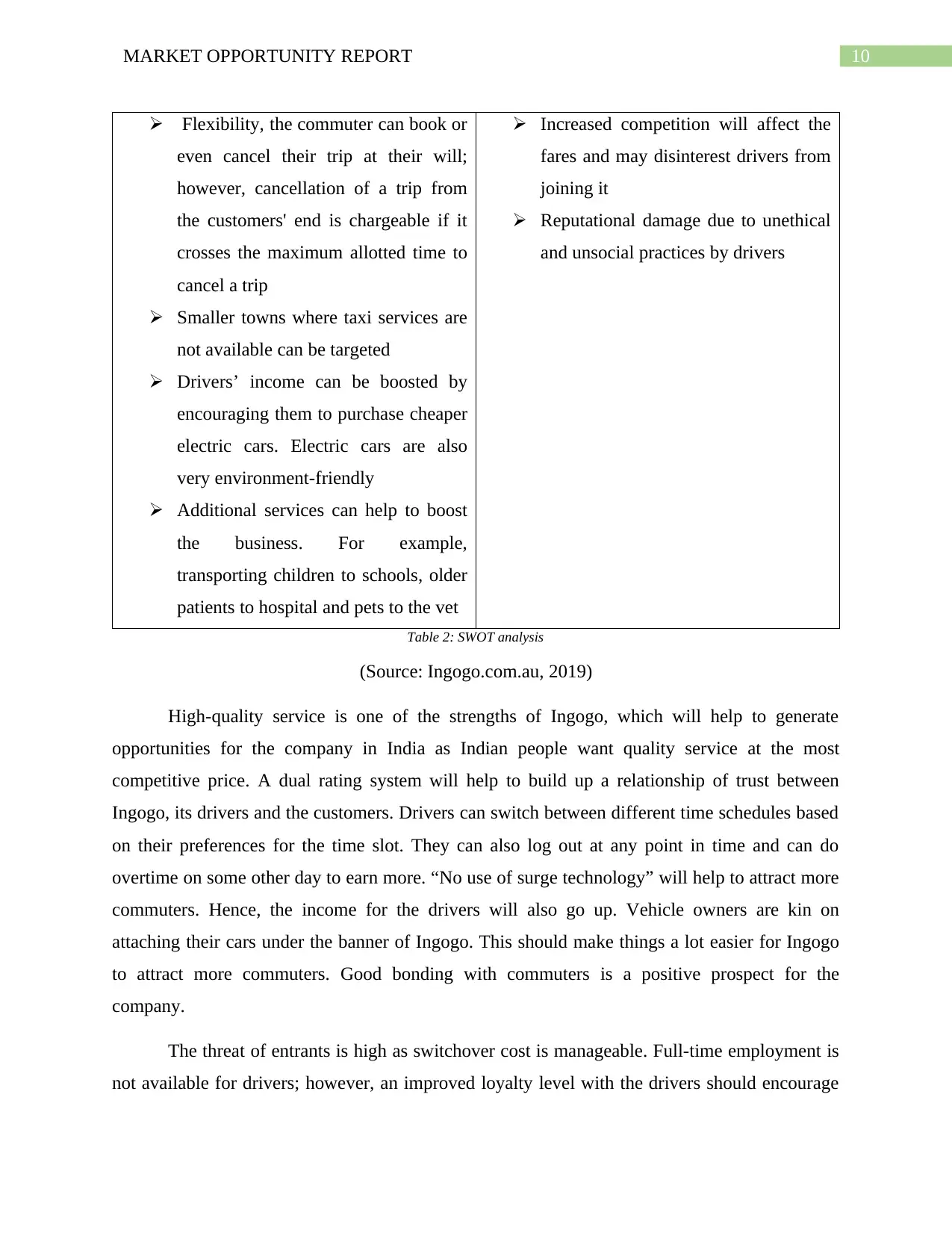
10MARKET OPPORTUNITY REPORT
Flexibility, the commuter can book or
even cancel their trip at their will;
however, cancellation of a trip from
the customers' end is chargeable if it
crosses the maximum allotted time to
cancel a trip
Smaller towns where taxi services are
not available can be targeted
Drivers’ income can be boosted by
encouraging them to purchase cheaper
electric cars. Electric cars are also
very environment-friendly
Additional services can help to boost
the business. For example,
transporting children to schools, older
patients to hospital and pets to the vet
Increased competition will affect the
fares and may disinterest drivers from
joining it
Reputational damage due to unethical
and unsocial practices by drivers
Table 2: SWOT analysis
(Source: Ingogo.com.au, 2019)
High-quality service is one of the strengths of Ingogo, which will help to generate
opportunities for the company in India as Indian people want quality service at the most
competitive price. A dual rating system will help to build up a relationship of trust between
Ingogo, its drivers and the customers. Drivers can switch between different time schedules based
on their preferences for the time slot. They can also log out at any point in time and can do
overtime on some other day to earn more. “No use of surge technology” will help to attract more
commuters. Hence, the income for the drivers will also go up. Vehicle owners are kin on
attaching their cars under the banner of Ingogo. This should make things a lot easier for Ingogo
to attract more commuters. Good bonding with commuters is a positive prospect for the
company.
The threat of entrants is high as switchover cost is manageable. Full-time employment is
not available for drivers; however, an improved loyalty level with the drivers should encourage
Flexibility, the commuter can book or
even cancel their trip at their will;
however, cancellation of a trip from
the customers' end is chargeable if it
crosses the maximum allotted time to
cancel a trip
Smaller towns where taxi services are
not available can be targeted
Drivers’ income can be boosted by
encouraging them to purchase cheaper
electric cars. Electric cars are also
very environment-friendly
Additional services can help to boost
the business. For example,
transporting children to schools, older
patients to hospital and pets to the vet
Increased competition will affect the
fares and may disinterest drivers from
joining it
Reputational damage due to unethical
and unsocial practices by drivers
Table 2: SWOT analysis
(Source: Ingogo.com.au, 2019)
High-quality service is one of the strengths of Ingogo, which will help to generate
opportunities for the company in India as Indian people want quality service at the most
competitive price. A dual rating system will help to build up a relationship of trust between
Ingogo, its drivers and the customers. Drivers can switch between different time schedules based
on their preferences for the time slot. They can also log out at any point in time and can do
overtime on some other day to earn more. “No use of surge technology” will help to attract more
commuters. Hence, the income for the drivers will also go up. Vehicle owners are kin on
attaching their cars under the banner of Ingogo. This should make things a lot easier for Ingogo
to attract more commuters. Good bonding with commuters is a positive prospect for the
company.
The threat of entrants is high as switchover cost is manageable. Full-time employment is
not available for drivers; however, an improved loyalty level with the drivers should encourage

11MARKET OPPORTUNITY REPORT
them to be a part of this growing business. Loan repayment becomes challenging as interest rates
are generally higher. It attracts a substantial amount of income. Data privacy can be an issue;
however, nothing so far has happened in this regard. Most of the people already know that their
information is being passed on to the ride-hailing services (Chee, 2018).
The service is quick and reliable, which makes it a dominating choice for many
commuters. It allows commuters no more waiting to get a taxi. Instead, they can book it in
advance 48 hours prior to their journey. For a longer journey, they can also book 7 days prior to
the journey. Smaller towns where taxi service is not available can be targeted. This could add a
boost to the business. Drivers’ income can be boosted by encouraging them to buy electric cars.
Electric cars are cheaper than non-electric cars. Moreover, it is also friendlier to the environment
as it emits a very low CO2 (Wilberforce et al., 2017).
Conflict with local authorities can earn reputational damage to Ingogo. The company can
also be needed to pay the penalties. Increased competition will force Ingogo to keep fares low.
This may disinterest the drivers as their income will be affected by this move. Any unsocial and
unethical practices being performed by the drivers will also earn reputational damage to the
company (Chee, 2018).
5. Conclusion
To conclude, it can be said that Ingogo should enter a new marketplace in the form of
India. India is a growing market for ride-hailing services. Uber and Ola are the dominating
service providers in such a large marketplace. The business model that Ingogo uses is absolutely
fit with the Indian people. However, a few challenges such as the government policy for cost
control mechanism can affect the popularity of ride-hailing services. This policy will bring fares
for both traditional taxis and app-based cabs more or less at the similar ground. Hence,
customers will switch between traditional taxis and ride-hailing services. The critical success
factors (CSFs) should be its existing business model, innovation to increase the income for the
drivers, and provide friendlier and cost-effective rides to the commuters.
them to be a part of this growing business. Loan repayment becomes challenging as interest rates
are generally higher. It attracts a substantial amount of income. Data privacy can be an issue;
however, nothing so far has happened in this regard. Most of the people already know that their
information is being passed on to the ride-hailing services (Chee, 2018).
The service is quick and reliable, which makes it a dominating choice for many
commuters. It allows commuters no more waiting to get a taxi. Instead, they can book it in
advance 48 hours prior to their journey. For a longer journey, they can also book 7 days prior to
the journey. Smaller towns where taxi service is not available can be targeted. This could add a
boost to the business. Drivers’ income can be boosted by encouraging them to buy electric cars.
Electric cars are cheaper than non-electric cars. Moreover, it is also friendlier to the environment
as it emits a very low CO2 (Wilberforce et al., 2017).
Conflict with local authorities can earn reputational damage to Ingogo. The company can
also be needed to pay the penalties. Increased competition will force Ingogo to keep fares low.
This may disinterest the drivers as their income will be affected by this move. Any unsocial and
unethical practices being performed by the drivers will also earn reputational damage to the
company (Chee, 2018).
5. Conclusion
To conclude, it can be said that Ingogo should enter a new marketplace in the form of
India. India is a growing market for ride-hailing services. Uber and Ola are the dominating
service providers in such a large marketplace. The business model that Ingogo uses is absolutely
fit with the Indian people. However, a few challenges such as the government policy for cost
control mechanism can affect the popularity of ride-hailing services. This policy will bring fares
for both traditional taxis and app-based cabs more or less at the similar ground. Hence,
customers will switch between traditional taxis and ride-hailing services. The critical success
factors (CSFs) should be its existing business model, innovation to increase the income for the
drivers, and provide friendlier and cost-effective rides to the commuters.
⊘ This is a preview!⊘
Do you want full access?
Subscribe today to unlock all pages.

Trusted by 1+ million students worldwide
1 out of 15
Related Documents
Your All-in-One AI-Powered Toolkit for Academic Success.
+13062052269
info@desklib.com
Available 24*7 on WhatsApp / Email
![[object Object]](/_next/static/media/star-bottom.7253800d.svg)
Unlock your academic potential
Copyright © 2020–2025 A2Z Services. All Rights Reserved. Developed and managed by ZUCOL.





